
| WWT Shows | CLICK TO: Join and Support Internet Horology Club 185™ | IHC185™ Forums |

|
• Check Out Our... • • TWO Book Offer! • |
Welcome Aboard IHC185™  Internet Horology Club 185
Internet Horology Club 185  IHC185™ Discussion Site Main Page
IHC185™ Discussion Site Main Page  Technical, Shop Talk and Internet Links
Technical, Shop Talk and Internet Links  Clock Repair Questions and Answers
Clock Repair Questions and Answers  Identification
Identification
 Internet Horology Club 185
Internet Horology Club 185  IHC185™ Discussion Site Main Page
IHC185™ Discussion Site Main Page  Technical, Shop Talk and Internet Links
Technical, Shop Talk and Internet Links  Clock Repair Questions and Answers
Clock Repair Questions and Answers  Identification
IdentificationGo  | New Topic  | Find-Or-Search  | Notify  | Tools  | Reply to Post  |  |
Can anyone help identify this movement? 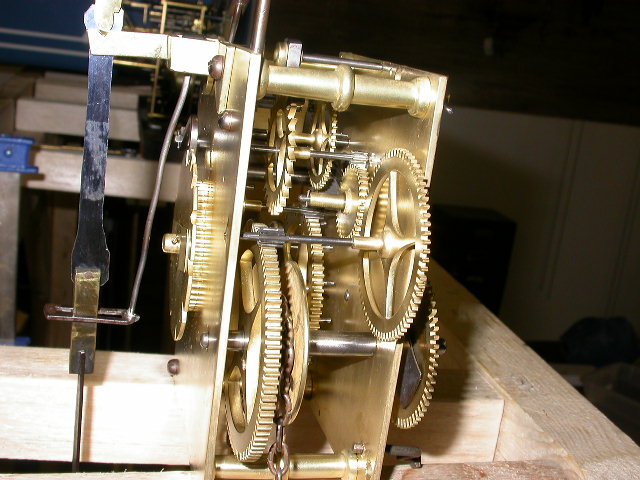 | |||
|
another picture. 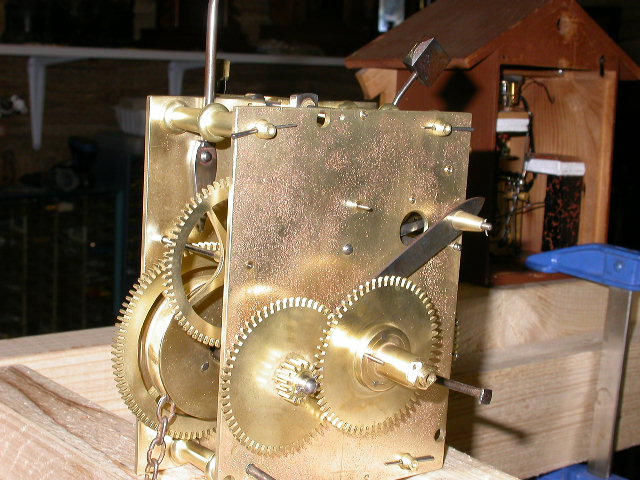 | ||||
|
and another one. 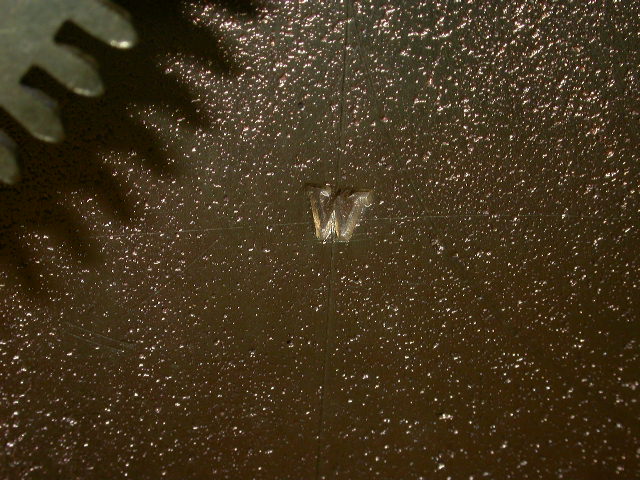 | ||||
|
The dial. I'll post a picture of the case after I deliver the movement.  | ||||
|
one more picture. 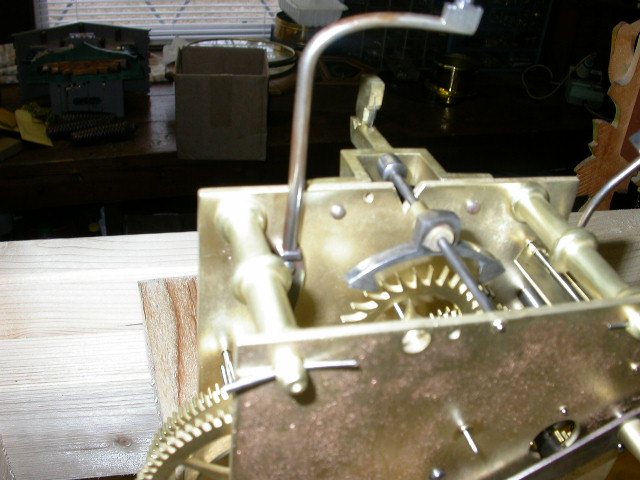 | ||||
|
the back. 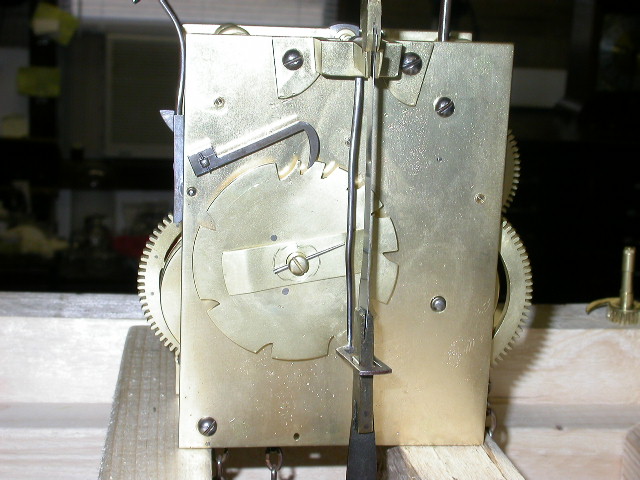 | ||||
|
Both strik train and time train run on the same weight. Thanks. Bob 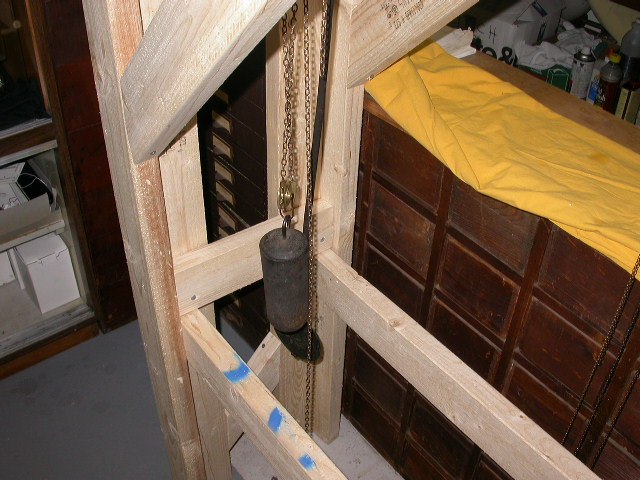 | ||||
|
I can't identify the maker, except that it looks English. Is it supposed to run with only one chain? It looks as though there is a main wheel for both trains, I've not seen this before. | ||||
|
HI Greg, Yes, the clock is designed to run on only one weight. The first I've seen too. I'll post more pictures if you would like to see some close up of the movement. I'm thinking it's very early (1810 or maybe earlier) American. I'll post a picture of the case (which is beautiful) later. Regards, Bob | ||||
|
yes, that would be great. I've heard of them, but not had one in for repair. By the way, looks like a great job on restoration. | ||||
|
This is the first two train, one weight, I have had after 35 years in this business. Very interesting clock. Wait until you see the case.I tried to take a picture of the chain driving both trains. I hope you can see it from this picture.  | ||||
|
I know there is a couple of links in the chain that needs to be "closed" and I also will polish it to the best it can be before it is delivered to my customer, so please don't send me emails. Warm regards, Bob | ||||
|
Hi Robert, I've found recorded a maker - Eli. Mather, West Bradford, Pa. USA 1828. This Could be your man and the date would fit the 'painted' (or 'white') dial also. I can't find any clockmakers recorded for Halifax UK (not far from where I live!), so guessing it's Halifax USA. Greg, the following may be relevent to your clock also, but I'll be replying to you shortly anyway. Around 'Mather's' time, painted dial 'mass manufacture' was big business, particularly in Birmingham UK where most of the 'dial makers' were operating. As well as making dials to suit individual movement plates, they were mainly produced already rivetted to a blank falseplate, which the clockmaker could fit to any movement, all he had to do was choose a dial 'off the shelf', and drill the plates to suit his movement. This was a big departure from brass dial manufacture, where they all had to be made to suit a particular movement - A Very unpopular development with engravers! Dials were exported to the USA in large numbers and were often left blank in production so that retailers, makers or even owners could have their own names and town names painted on them. A name on a dial in some cases, may not have any relevence to a maker or where made at all. Alongside this, clock movements were also becoming more 'mass produced', and also being exported. Clock 'Makers' bought in all the components, so in reality just 'refinished' them. A give away, is a lack of scribe marks around the pivot holes on such 'jig drilled' plates, which would be present on a 'hand made' movement caused by the depthing tool. The 'W' stamped into the wheel may suggest a 'logo' of such a mass 'manufacturer! Your clock could be either totally American in origin, or an early form of 'kit build' for which Mather may have 'bought in' all the bits to assemble 'at home' in his own longcase Must confess, I've never seen two trains running on one weight 'till now! Looks a very nice movement though, and a beautifully executed restoration if I may say so. Best regards John Woolsey | ||||
|
Robert, That is a VERY INTERESTING clock. I have not seen one like it. Is the second hole in the dial just empty or is there a false winding arbor to make it look right? Tom | ||||
|
Thanks you for the information John. Thanks for the compliment too. That makes sense to me. I have seen the case and it does look American to me but I'm no expert on floor clocks. This is a first for me too and I've been doing this for 37 years. I'll post a picture of the case a little later on. Tom, there there are are two false winding arbors. One of them is stripped and I had not repaired it at the time of posting the first pictures. Here is another picture with the dial on. Kind regards, Bob 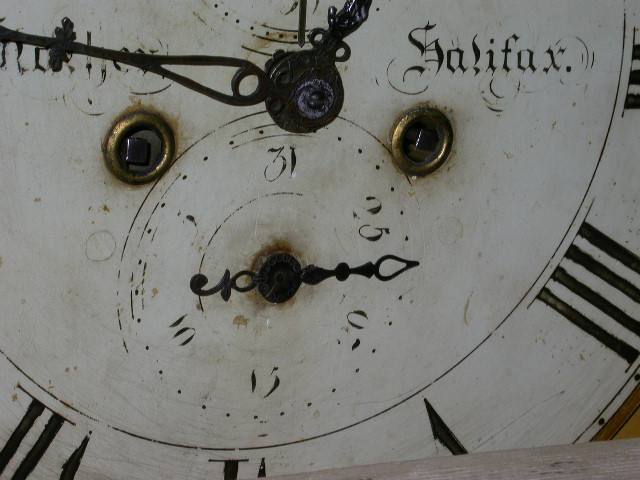 | ||||
|
from the bottom of the clock. Maybe you can see the chain working both trains.  | ||||
|
Actually that is a very common 30-hour continuous chain movement with outside countwheel strike. They were the cheaper tall case movements that had the false winding arbors to look like a more expensive 8-day type. Mike C. | ||||
|
One more thing, many were rope-pull, the sprocket had spikes for the rope to catch on and a counter-weight(donut-shaped) that the loose end of the chain would go through to keep the rope taut for proper 'tracking' over the sprocket. The counter-weight was used on the chain-pull also. I could not see from the pics if yours had a counter-weight. Mike C. | ||||
|
Thanks for your information Mike. This one didn't have a counter weight when I picked it up. Maybe it should have but it has been working fine for the last week of so. Regards, Bob | ||||
|
Your welcome Bob | ||||
|
The case. | ||||
|
The bottom/feet of the clock | ||||
|
Back of clock | ||||
|
What a case. Love that wood. Great clock!! Tom | ||||
|
I don't have a clue what the wood is but I agree, it is Beautiful. My customer bought a house here in Fredericksburg and got the clock with it. Such a deal. If anyone has an estimate of the value, please let me know. Thanks, Bob | ||||
|
| Powered by Social Strata |
| Your request is being processed... |
|
©2002-2025 Internet Horology Club 185™ - Lindell V. Riddle President - All Rights Reserved Worldwide

